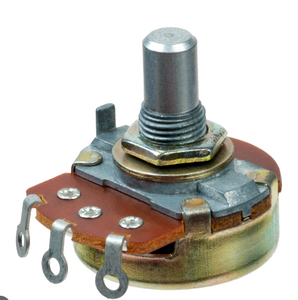Does anyone have experience weatherproofing/waterproofing one of these bad boys?
Here is some background, I want to use a 1200 ohm one for a wheel angle sensor on my tractor. I'm trying to come up with a way to make one of these work in my application.
I currently have sourced a landrover suspension height sensor, which is what i'm using now, so i am aware weather proof pots do exist in the world of automotive/sensor world. The reason i'm asking the question about making one of these weatherproof is two fold. I'm trying to find a cheaper option. Most automotive grade sensors are in the $50 to $150 dollar range, and like the land rover i'm using now, have limited sensor range. i think it has vision for only 35 degrees of turn out of the 360 arc. One of these pots works great, and gives you a much wider range of vision using 0-5v. The best part is i can get them for $1.25 which leaves a lot of room for a weather proofing system for it, i just don't know where to start. Encase in epoxy? o-ring sealed 3d printed box?
I do need an arm to come off to attach to the tie-rod to rotate it so that would probably be the source of the leak.
@fastrunner08 I just googled 'weatherproof potentiometer' and it turned up lots. Also any marine specific pots will have to be water proof. What you really need to look for is the IP rating.
HOWEVER none of those are designed to be used the way you want to use it so that will be an issue.
I think a restatating of the problem you are trying to solve may yield a different approach.
First computer 1959. Retired from my own computer company 2004.
Hardware - Expert in 1401, and 360, fairly knowledge in PC plus numerous MPU's and MCU's
Major Languages - Machine language, 360 Macro Assembler, Intel Assembler, PL/I and PL1, Pascal, Basic, C plus numerous job control and scripting languages.
Sure you can learn to be a programmer, it will take the same amount of time for me to learn to be a Doctor.
Weatherproofing shouldn't be an issue, your idea with the 3D printed box and o-ring sounds workable. You can also get those plastic project cases on Amazon that have the weatherproofing seal, I've used those for outdoor projects, and they survive our Canadian winters and summers just fine.
Personally, I suspect the biggest issue with the pot you are using is the tolerance. Those cheap pots are generally in the 10% or worse category, and if you are experiencing temperature extremes they could be even worse. Since you say you're only using about 35% of the pot travel, it won't be that accurate.
If you are going to 3D print a case, perhaps you could also print some gears. This would allow you to keep the pot completely sealed, and the gears could work it so the 35% turns the pot a full 180 degrees. You could even gear it for a 10-turn precision pot if you want accuracy.
😎
Bill
"Never trust a computer you can’t throw out a window." — Steve Wozniak

